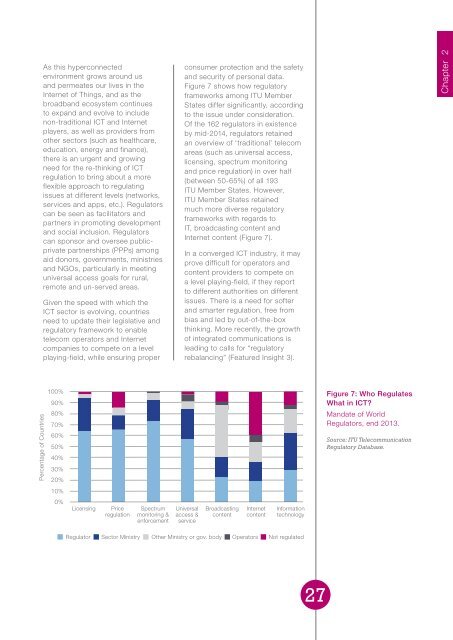Chapter 2Featured Insight 2:The Internet is Evolving– from Connected Thingsto Connected EverythingThe rise of the Internet of Everythingmay be the biggest fundamentaltechnological change since thedevelopment of the Internet. Already,the Internet of Everything is havinga profound impact, as people,processes, data, things, communities,and countries become increasinglyconnected. The Internet of Everythingrepresents a US$19 trillion globalopportunity to create value overthe next decade through greaterprofits for businesses, as well asimprovements to citizen services, costefficiencies, and increased revenuesfor governments and public sectororganizations (Cisco, 2014). With therise of cloud, mobility and big dataand the Internet of Everything, thetraditional role of IT is changing, andInternet Protocol (IP) networks areplaying a central role in connectingdisparate IT environments. Theexplosive expansion of direct M2Mconnections between context-awaremachines and other physical objectsis changing how we use devicesto improve our daily lives. And theshift in data and analytics ─ fromcentralized, structured, and statictowards distributed, mixed structuredand unstructured, and real-time ─is leading to a new era of real-timeprocessing and decision-making.The migration to IP networks and theability to turn big data into valuable,actionable information offer majoreconomic and social benefits. Thenetwork is a critical accelerator andenabler in all of these transitions,accelerating the utilization of dataand transforming processes toincrease efficiency and decreasecosts. IP networks are now connectingbillions of physical devices, while thisaccelerating volume of data is drivenby four major trends:• IP is fast becoming the commonlanguage for most datacommunication, especiallyproprietary industrial networks.• Billions more people, things,places, processes and deviceswill come online over the next fiveyears.• Existing physically storedinformation is being digitizedin order to record and sharepreviously analogue material. Forexample, the digital share of theworld’s stored information hasincreased from 25% to over 98%over the last decade 38 .• The introduction of InternetProtocol version 6 (IPv6) nowremoves the technical limit on thenumber of devices connected tothe Internet, allowing for trillions oftrillions (i.e. 10 38 ) of devices.Improving the ability of IP networksto transmit data for processing, aswell as enabling networks to create,analyze and act on data insights canaccelerate the positive impact frombig data. Building this capabilitywill require improving networkinfrastructure, enhancing analyticalcapabilities and ‘intelligence’ inthe network through distributedcomputing. Critical challenges willalso need to be addressed, includingrobust industry standards forinteroperability, privacy and security.Source: Dr. Robert Pepper, Vice-Presidentfor Global Technology Policy, Cisco Systems.26
As this hyperconnectedenvironment grows around usand permeates our lives in theInternet of Things, and as thebroadband ecosystem continuesto expand and evolve to includenon-traditional ICT and Internetplayers, as well as providers fromother sectors (such as healthcare,education, energy and finance),there is an urgent and growingneed for the re-thinking of ICTregulation to bring about a moreflexible approach to regulatingissues at different levels (networks,services and apps, etc.). Regulatorscan be seen as facilitators andpartners in promoting developmentand social inclusion. Regulatorscan sponsor and oversee publicprivatepartnerships (PPPs) amongaid donors, governments, ministriesand NGOs, particularly in meetinguniversal access goals for rural,remote and un-served areas.Given the speed with which theICT sector is evolving, countriesneed to update their legislative andregulatory framework to enabletelecom operators and Internetcompanies to compete on a levelplaying-field, while ensuring properconsumer protection and the safetyand security of personal data.Figure 7 shows how regulatoryframeworks among ITU MemberStates differ significantly, accordingto the issue under consideration.Of the 162 regulators in existenceby mid-2014, regulators retainedan overview of ‘traditional’ telecomareas (such as universal access,licensing, spectrum monitoringand price regulation) in over half(between 50-65%) of all 193ITU Member States. However,ITU Member States retainedmuch more diverse regulatoryframeworks with regards toIT, broadcasting content andInternet content (Figure 7).In a converged ICT industry, it mayprove difficult for operators andcontent providers to compete ona level playing-field, if they reportto different authorities on differentissues. There is a need for softerand smarter regulation, free frombias and led by out-of-the-boxthinking. More recently, the growthof integrated communications isleading to calls for “regulatoryrebalancing” (Featured Insight 3).Chapter 2Percentage of Countries100%90%80%70%60%50%40%30%20%Figure 7: Who RegulatesWhat in ICT?Mandate of WorldRegulators, end 2013.Source: ITU TelecommunicationRegulatory Database.10%0%LicensingPriceregulationSpectrummonitoring &enforcementUniversalaccess &serviceBroadcastingcontentInternetcontentInformationtechnologyRegulator Sector Ministry Other Ministry or gov. body Operators Not regulated27


